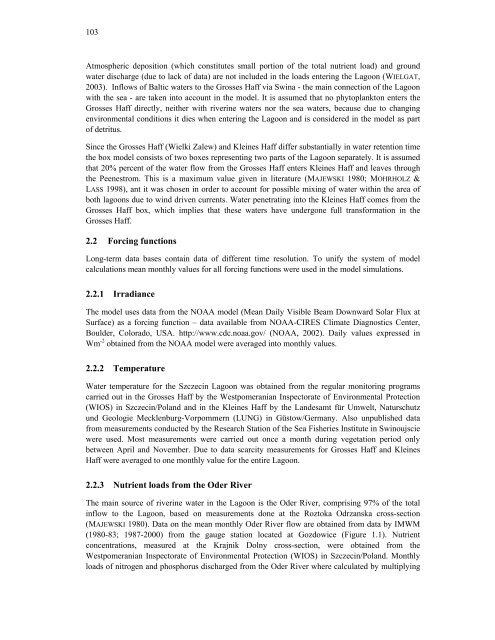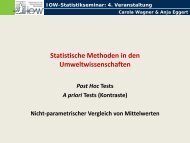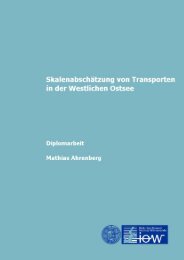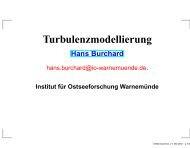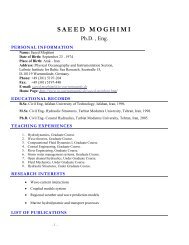The Oder Estuary - IOW
The Oder Estuary - IOW
The Oder Estuary - IOW
Erfolgreiche ePaper selbst erstellen
Machen Sie aus Ihren PDF Publikationen ein blätterbares Flipbook mit unserer einzigartigen Google optimierten e-Paper Software.
103<br />
Atmospheric deposition (which constitutes small portion of the total nutrient load) and ground<br />
water discharge (due to lack of data) are not included in the loads entering the Lagoon (WIELGAT,<br />
2003). Inflows of Baltic waters to the Grosses Haff via Swina - the main connection of the Lagoon<br />
with the sea - are taken into account in the model. It is assumed that no phytoplankton enters the<br />
Grosses Haff directly, neither with riverine waters nor the sea waters, because due to changing<br />
environmental conditions it dies when entering the Lagoon and is considered in the model as part<br />
of detritus.<br />
Since the Grosses Haff (Wielki Zalew) and Kleines Haff differ substantially in water retention time<br />
the box model consists of two boxes representing two parts of the Lagoon separately. It is assumed<br />
that 20% percent of the water flow from the Grosses Haff enters Kleines Haff and leaves through<br />
the Peenestrom. This is a maximum value given in literature (MAJEWSKI 1980; MOHRHOLZ &<br />
LASS 1998), ant it was chosen in order to account for possible mixing of water within the area of<br />
both lagoons due to wind driven currents. Water penetrating into the Kleines Haff comes from the<br />
Grosses Haff box, which implies that these waters have undergone full transformation in the<br />
Grosses Haff.<br />
2.2 Forcing functions<br />
Long-term data bases contain data of different time resolution. To unify the system of model<br />
calculations mean monthly values for all forcing functions were used in the model simulations.<br />
2.2.1 Irradiance<br />
<strong>The</strong> model uses data from the NOAA model (Mean Daily Visible Beam Downward Solar Flux at<br />
Surface) as a forcing function – data available from NOAA-CIRES Climate Diagnostics Center,<br />
Boulder, Colorado, USA. http://www.cdc.noaa.gov/ (NOAA, 2002). Daily values expressed in<br />
Wm -2 obtained from the NOAA model were averaged into monthly values.<br />
2.2.2 Temperature<br />
Water temperature for the Szczecin Lagoon was obtained from the regular monitoring programs<br />
carried out in the Grosses Haff by the Westpomeranian Inspectorate of Environmental Protection<br />
(WIOS) in Szczecin/Poland and in the Kleines Haff by the Landesamt für Umwelt, Naturschutz<br />
und Geologie Mecklenburg-Vorpommern (LUNG) in Güstow/Germany. Also unpublished data<br />
from measurements conducted by the Research Station of the Sea Fisheries Institute in Swinoujscie<br />
were used. Most measurements were carried out once a month during vegetation period only<br />
between April and November. Due to data scarcity measurements for Grosses Haff and Kleines<br />
Haff were averaged to one monthly value for the entire Lagoon.<br />
2.2.3 Nutrient loads from the <strong>Oder</strong> River<br />
<strong>The</strong> main source of riverine water in the Lagoon is the <strong>Oder</strong> River, comprising 97% of the total<br />
inflow to the Lagoon, based on measurements done at the Roztoka Odrzanska cross-section<br />
(MAJEWSKI 1980). Data on the mean monthly <strong>Oder</strong> River flow are obtained from data by IMWM<br />
(1980-83; 1987-2000) from the gauge station located at Gozdowice (Figure 1.1). Nutrient<br />
concentrations, measured at the Krajnik Dolny cross-section, were obtained from the<br />
Westpomeranian Inspectorate of Environmental Protection (WIOS) in Szczecin/Poland. Monthly<br />
loads of nitrogen and phosphorus discharged from the <strong>Oder</strong> River where calculated by multiplying


